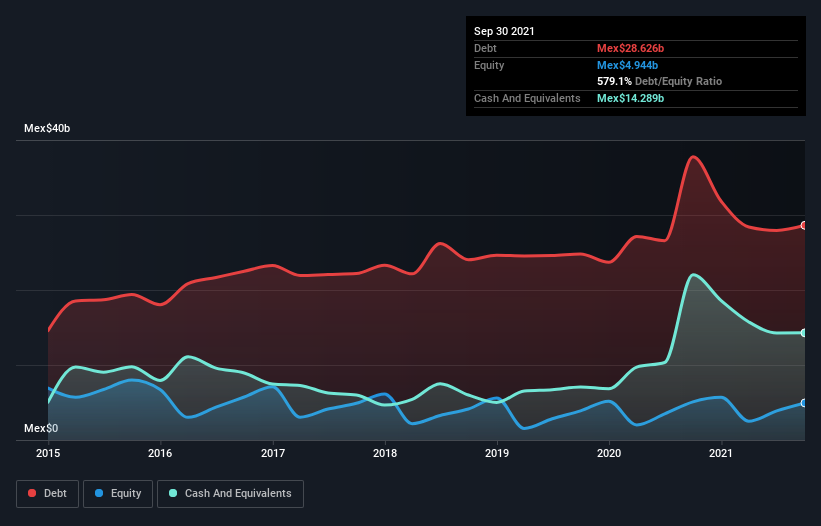- Mexico
- /
- Household Products
- /
- BMV:KIMBER A
These 4 Measures Indicate That Kimberly-Clark de México S. A. B. de C. V (BMV:KIMBERA) Is Using Debt Reasonably Well

The external fund manager backed by Berkshire Hathaway's Charlie Munger, Li Lu, makes no bones about it when he says 'The biggest investment risk is not the volatility of prices, but whether you will suffer a permanent loss of capital.' When we think about how risky a company is, we always like to look at its use of debt, since debt overload can lead to ruin. As with many other companies Kimberly-Clark de México, S. A. B. de C. V. (BMV:KIMBERA) makes use of debt. But the more important question is: how much risk is that debt creating?
When Is Debt A Problem?
Generally speaking, debt only becomes a real problem when a company can't easily pay it off, either by raising capital or with its own cash flow. If things get really bad, the lenders can take control of the business. However, a more usual (but still expensive) situation is where a company must dilute shareholders at a cheap share price simply to get debt under control. By replacing dilution, though, debt can be an extremely good tool for businesses that need capital to invest in growth at high rates of return. The first thing to do when considering how much debt a business uses is to look at its cash and debt together.
Check out our latest analysis for Kimberly-Clark de México S. A. B. de C. V
What Is Kimberly-Clark de México S. A. B. de C. V's Net Debt?
The image below, which you can click on for greater detail, shows that Kimberly-Clark de México S. A. B. de C. V had debt of Mex$28.6b at the end of September 2021, a reduction from Mex$37.8b over a year. However, because it has a cash reserve of Mex$14.3b, its net debt is less, at about Mex$14.3b.

A Look At Kimberly-Clark de México S. A. B. de C. V's Liabilities
According to the last reported balance sheet, Kimberly-Clark de México S. A. B. de C. V had liabilities of Mex$17.4b due within 12 months, and liabilities of Mex$28.2b due beyond 12 months. Offsetting these obligations, it had cash of Mex$14.3b as well as receivables valued at Mex$6.97b due within 12 months. So its liabilities outweigh the sum of its cash and (near-term) receivables by Mex$24.3b.
While this might seem like a lot, it is not so bad since Kimberly-Clark de México S. A. B. de C. V has a market capitalization of Mex$94.3b, and so it could probably strengthen its balance sheet by raising capital if it needed to. But it's clear that we should definitely closely examine whether it can manage its debt without dilution.
In order to size up a company's debt relative to its earnings, we calculate its net debt divided by its earnings before interest, tax, depreciation, and amortization (EBITDA) and its earnings before interest and tax (EBIT) divided by its interest expense (its interest cover). The advantage of this approach is that we take into account both the absolute quantum of debt (with net debt to EBITDA) and the actual interest expenses associated with that debt (with its interest cover ratio).
While Kimberly-Clark de México S. A. B. de C. V's low debt to EBITDA ratio of 1.3 suggests only modest use of debt, the fact that EBIT only covered the interest expense by 5.1 times last year does give us pause. So we'd recommend keeping a close eye on the impact financing costs are having on the business. Sadly, Kimberly-Clark de México S. A. B. de C. V's EBIT actually dropped 9.6% in the last year. If that earnings trend continues then its debt load will grow heavy like the heart of a polar bear watching its sole cub. When analysing debt levels, the balance sheet is the obvious place to start. But ultimately the future profitability of the business will decide if Kimberly-Clark de México S. A. B. de C. V can strengthen its balance sheet over time. So if you're focused on the future you can check out this free report showing analyst profit forecasts.
Finally, a company can only pay off debt with cold hard cash, not accounting profits. So we always check how much of that EBIT is translated into free cash flow. Over the last three years, Kimberly-Clark de México S. A. B. de C. V recorded free cash flow worth a fulsome 86% of its EBIT, which is stronger than we'd usually expect. That puts it in a very strong position to pay down debt.
Our View
When it comes to the balance sheet, the standout positive for Kimberly-Clark de México S. A. B. de C. V was the fact that it seems able to convert EBIT to free cash flow confidently. But the other factors we noted above weren't so encouraging. For example, its EBIT growth rate makes us a little nervous about its debt. Considering this range of data points, we think Kimberly-Clark de México S. A. B. de C. V is in a good position to manage its debt levels. But a word of caution: we think debt levels are high enough to justify ongoing monitoring. There's no doubt that we learn most about debt from the balance sheet. However, not all investment risk resides within the balance sheet - far from it. To that end, you should be aware of the 2 warning signs we've spotted with Kimberly-Clark de México S. A. B. de C. V .
If you're interested in investing in businesses that can grow profits without the burden of debt, then check out this free list of growing businesses that have net cash on the balance sheet.
Valuation is complex, but we're here to simplify it.
Discover if Kimberly-Clark de México S. A. B. de C. V might be undervalued or overvalued with our detailed analysis, featuring fair value estimates, potential risks, dividends, insider trades, and its financial condition.
Access Free AnalysisHave feedback on this article? Concerned about the content? Get in touch with us directly. Alternatively, email editorial-team (at) simplywallst.com.
This article by Simply Wall St is general in nature. We provide commentary based on historical data and analyst forecasts only using an unbiased methodology and our articles are not intended to be financial advice. It does not constitute a recommendation to buy or sell any stock, and does not take account of your objectives, or your financial situation. We aim to bring you long-term focused analysis driven by fundamental data. Note that our analysis may not factor in the latest price-sensitive company announcements or qualitative material. Simply Wall St has no position in any stocks mentioned.
About BMV:KIMBER A
Kimberly-Clark de México S. A. B. de C. V
Manufactures, distributes, and sells disposable products in Mexico.
Flawless balance sheet with solid track record and pays a dividend.
Similar Companies
Market Insights
Community Narratives




